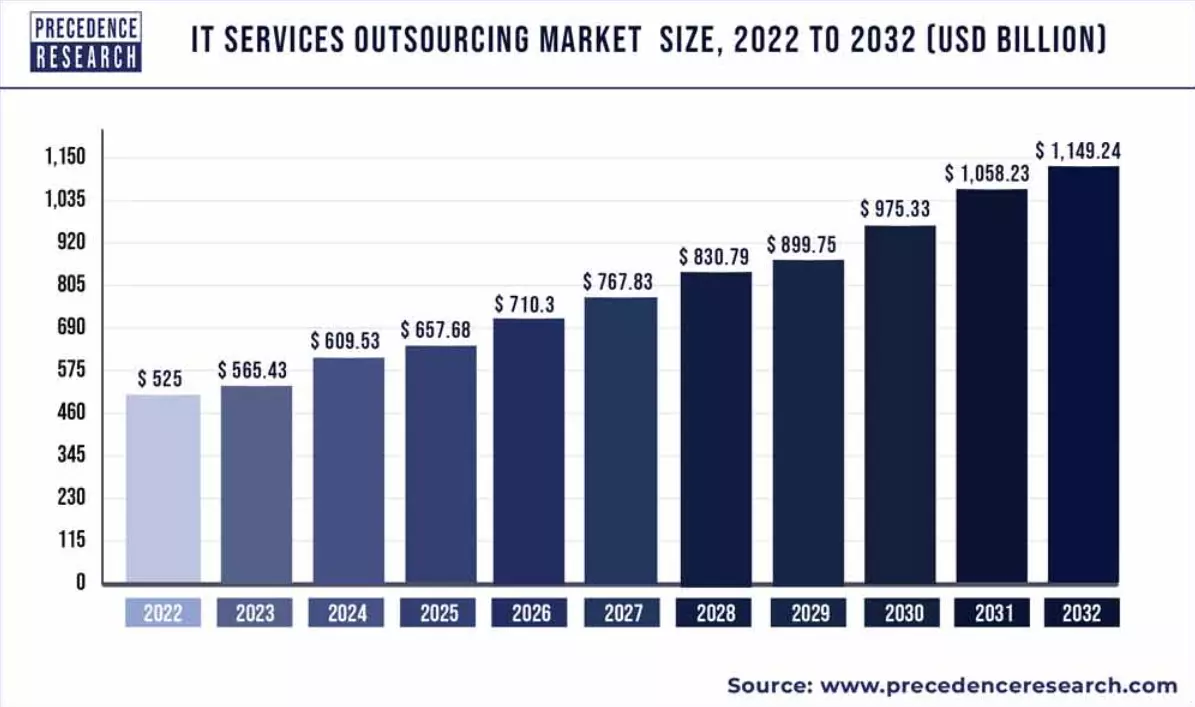
Martyna Lubańska
22 November 2023, 6 min read

What's inside
- What is Software Development Outsourcing?
- Pros and cons of outsourcing software development
- How to Prepare for Outsourcing a Project to a Software Company?
- Conclusion
- Ready to Elevate Your Business?
The global IT services outsourcing market size was estimated at USD 525 billion in 2022, and it is expected to hit around USD 1,149.24 billion by 2032, poised to grow at a compound annual growth rate (CAGR) of 8.2% during the forecast period 2023 to 2032.

Businesses of all sizes are now turning to outsourcing as a strategy for increasing their productivity and time-to-market of their products. It's simple: hiring in-house development teams is expensive, time-consuming, and increasingly challenging. By teaming up with a software development company, organizations get to enjoy many benefits at minimal risk.
If you are considering outsourcing, this article is for you. Read on to find out how to prepare an outsourcing plan in four steps and drive your business growth through outsourced software development.
What is Software Development Outsourcing?
Software development outsourcing refers to the common practice of delegating the task of building software to a third-party service provider. Companies outsource projects or specific business areas to qualified external partners with the resources, talent, experience, and time to meet the business requirements in a specified timeframe.
Why are so many companies choosing to outsource software development? Keeping up with the rapidly changing world of technology is challenging for a company looking to optimize its operations or grow their digital products. While in-house development teams provide the reliability and stability many organizations need, they also have their limits.
Companies need to reach their objectives faster, stay within budget, and build a competitive advantage on the market. To achieve that, they require talented IT experts – and finding such people can be difficult and expensive, depending on the local job market. That's why outsourcing has become such a popular solution, offering these companies the ability to transfer their technology needs to experienced outsourcing companies and build high-quality software with the help of talent worldwide.
How does outsourcing software development work in practice? Read this case study: How our team built key product features for the employee performance tool 15Five
Pros and cons of outsourcing software development
Outsourcing software development offers a multitude of benefits and, at the same time, presents certain challenges. Understanding these can help businesses make informed decisions.
| Cons |
|---|
| Pros |
| High availability – Outsourcing guarantees excellent uptime, making operations smoother compared to in-house teams, which various factors can disrupt. |
| Expertise and skills – Outsourced teams often bring a wealth of knowledge and specialized skills of significant value to business operations. |
| Scalability – Outsourcing offers a flexible solution that can be expanded or reduced based on evolving business needs, as opposed to fixed-size in-house teams. |
| Focus on core operations – Outsourcing allows businesses to concentrate on their primary goals and crucial tasks. |
| Versatility – Outsourcing partners can adjust their offerings to cater to changing business requirements. |
| Resource optimization – Outsourcing non-critical tasks ensures in-house teams remain focused on vital projects. |
For smaller companies especially, the decision to outsource can be transformative. As Łukasz Karwacki, co-founder of Sunscrapers, says,
Small companies rarely have the resources required for implementing all the systems they need in-house. Software licenses and hardware maintenance can be very expensive. By outsourcing IT activities, smaller businesses get to the same playing field as the larger ones.
Moreover, selecting the right partners is essential when diving into the outsourcing realm. Drawing on his experience, Łukasz advises,
When looking for an outsourcing company, pay attention to the size and scope of the projects the team has delivered. While some providers handle multi-year software projects, others specialize in building business intelligence apps for sectors like finance.
For a deeper dive into the benefits and challenges of outsourcing, check out our in-depth articles:
- What are the benefits of outsourcing IT services?
- 4 Good Reasons Yous Should Consider Outsourcing to Poland
- How to Find the Leading Software Outsourcing Company?
How to Prepare for Outsourcing a Project to a Software Company?
Step 1: Assign Roles and Responsibilities
Clear demarcation of roles streamlines the process and establishes accountability.
Best practice: Assign a Product Owner
Łukasz Karwacki highlights the importance of clear leadership in outsourcing:
Even the best development team needs proper direction. The Product Owner acts as the quality guardian, ensuring the product development process moves in the right direction.
It's pivotal to have someone who understands your business objectives and pain points in-depth to guide the outsourced team effectively. The Product Owner bridges this gap, offering insights to make the partnership productive.
Step 2: Create a Backlog of Tasks
To ensure cohesion and clarity, preparing a backlog of tasks is indispensable. It equips the outsourced team with a roadmap, ensuring alignment with your business objectives.
Łukasz offers valuable advice:
Planning remains integral, especially when collaborating with teams that might not see the big picture of your operations. Starting with a clear blueprint sets the right expectations and allows for early identification of potential roadblocks.
Step 3: Select Your Tools
Effective collaboration is underpinned by robust tools. Here are some areas to focus on:
- Project Management: Platforms like Jira or Trello can aid in tracking progress.
- Accounting and Time Tracking: Tools like Harvest or Toggl can provide insights into the outsourced team's time allocation.
- Document Sharing: Seamless documentation is pivotal. Opt for platforms like Google Drive or Dropbox to ensure efficient knowledge transfer.
Step 4: Anticipate Dependencies
Preparation doesn't end with establishing tasks. It's vital to foresee potential hurdles. Identify dependencies early on to prevent roadblocks later. Ensure the outsourced team has access to essential platforms and interfaces.
Łukasz underlines this importance, asserting,
Prior identification of dependencies minimizes potential bottlenecks, ensuring a smoother collaboration.
Conclusion
Outsourcing, when approached with preparation and clarity, can immensely benefit businesses, offering them a competitive edge. As Łukasz Karwacki rightly emphasizes, the collaboration's success hinges on clear planning and open communication. For those venturing into outsourcing, the journey, though challenging, can be rewarding with the right strategies in place.
Ready to Elevate Your Business?
At Sunscrapers, we don't just offer outsourcing services — we set the gold standard. Dive into a partnership with us and experience why we're recognized as the best in the business. Let's bring your vision to life with unmatched expertise and passion.


